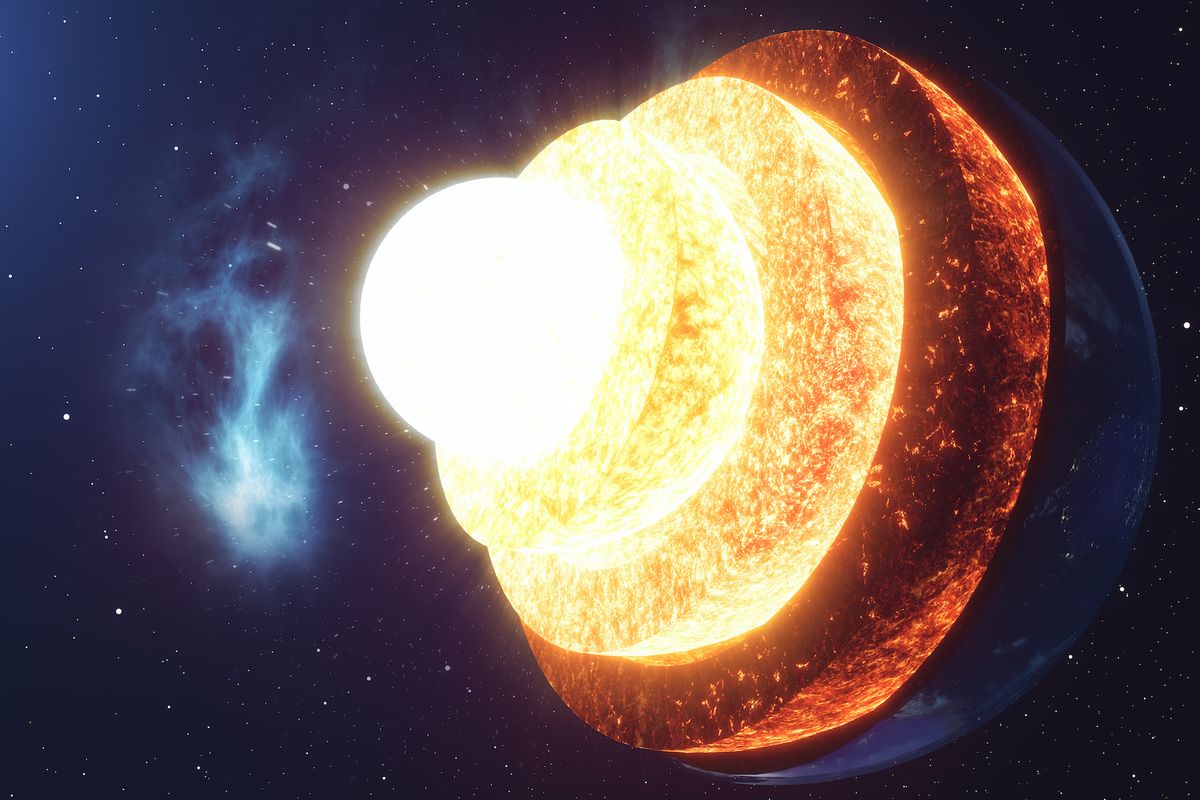With or without human interference each revolution around the sun creates a carbon layer for Earth. The Earth grows. When the Earth grows it places more gravitational force on the moon which is what causes the moon to move away from Earth. The moon's orbit is only partially understood by science. Science did not see or account for Earth’s belly.
Other than Earth the sun is the only thing that gains (significant) mass in our solar system post solar creation event.
Modern science says in time our planet the Earth will be consumed by a Red Dwarf stellar event. This is partially correct.
Space is easy if you turn the light on. Space is saturated in frozen hydrogen molecules. To create a star all you need is a source of heat. Put a heating element in space and turn it on. Hydrogen takes care of everything else. What we would notice is that we are blind and possibly incinerated. The light from a hydrogen helium reaction is blindingly bright and hot. The Big Bang universe is primarily, if not solely, hydrogen and iron. The expansion milky way universe is very similar in primary composition but the stars are born in binary pairs and the area is covered in cloudlike debris. There seems to be continuity to the milky way universe. The core of all planets and stars is iron alloy like ours. Iron may have a vaporized abundance in space though not as dense as hydrogen which is everywhere.
Our planet Earth’s core has long been cooling. We image Earth’s core through earthquakes. Along the North South Axis of the core our core has gone crystalline. The crystalline process is interesting as a cooling process; it defies the 2nd law of thermodynamics. It creates heat. The Earth’s core will begin heating once the highly evolved species on the surface of the planet perform their function. I know the function but cannot tell you yet.
Once the core has begun it’s heating phase the Earth will begin to expand; at least one new continent most likely two or three will be added to Earth’s surface. In many years the Oceans will evaporate and the land will become molten. We will know the end is near when cicadas cease to appear.
As Earth grows Earth’s moon will collide with Venus changing Venus’ orbital path. This creates chaos in the inner universe. Earth and Venus begin regular collisions. Earth is molten it will begin to collide with Venus. This will result in Earth, Venus, Mars and Mercury all covered in a carbon rich Lava. This will create an enormous release of heat in the universe which is stoking the sun as the sun being the larger mass gains more hydrogen mass from the heat. The planets will run into the surface of the sun once the planets are covered with lava.
The surface of the sun has long been misunderstood to be plasma. Plasma exists directly below the lava layer and is a byproduct of the hydrogen reaction. Carbon is also produced by the hydrogen reaction of the star. This carbon builds a pillar through the north south axis of the star. The pillar is later ejected by a stellar event. The carbon pillar is how the sun expels carbon deposits to the LAVA surface layer which results in sunspots as the surface layer as the heat gradually melts the carbon deposits. The carbon deposits on the sun are the only thing that makes our planet inhabitable. Plasma does not offer enough diffusion of light and heat. The top layer of the sun is silicate and oxygen rich in carbon. Lava lampshade. There is a plasma layer directly beneath the lava layer that is produced by the star. The protostar produces the carbon and lava but a good portion of our Sun’s lava layer will be passed onto the next generation of stars through red dwarf stellar event.
Once the planet/protostars or moons come in contact with the lava on the surface of the sun they migrate to either the north or south pole. Our moon will be the first to run into the sun. The sun has a carbon pillar at its north south axis. This carbon pillar shields the planet/protostars from extreme heat vaporization. The pillar also has a function for the star as some kind of carbon aspiration and the planet or moon will disrupt the aspiration and trigger the red dwarf expansion. During expansion the planets/protostars get covered in a carbon layer coating as the lava layer will also migrate to the north south poles of the star. The planets, lava layer, the IRON CORE and carbon are all fused into the carbon pillar. Once the red dwarf goes supernova the pillar is ejected both from it’s north and south axis. The pillar has ripped the iron core of the star in half which triggers the supernova blast. The star remnant is the plasma layer and others that condense rapidly under the force of gravity.
The north south ejection pillar is actually a star birthing activity of four new stars: a binary pair per axis. In addition to the pillars molecular clouds are also ejected. The molecular clouds sit in stasis after the event outside the solar system. The protostars will gradually melt the carbon and begin collision with the pillar and protostar pair. The prostars will also create a solar wind. Space is rich in frozen hydrogen molecules. Molecular clouds collapse and the rest is as is observed by science.
Science missed the spark. I think this one is much better but am no scientist.
Other than Earth the sun is the only thing that gains (significant) mass in our solar system post solar creation event.
Modern science says in time our planet the Earth will be consumed by a Red Dwarf stellar event. This is partially correct.
Space is easy if you turn the light on. Space is saturated in frozen hydrogen molecules. To create a star all you need is a source of heat. Put a heating element in space and turn it on. Hydrogen takes care of everything else. What we would notice is that we are blind and possibly incinerated. The light from a hydrogen helium reaction is blindingly bright and hot. The Big Bang universe is primarily, if not solely, hydrogen and iron. The expansion milky way universe is very similar in primary composition but the stars are born in binary pairs and the area is covered in cloudlike debris. There seems to be continuity to the milky way universe. The core of all planets and stars is iron alloy like ours. Iron may have a vaporized abundance in space though not as dense as hydrogen which is everywhere.
Our planet Earth’s core has long been cooling. We image Earth’s core through earthquakes. Along the North South Axis of the core our core has gone crystalline. The crystalline process is interesting as a cooling process; it defies the 2nd law of thermodynamics. It creates heat. The Earth’s core will begin heating once the highly evolved species on the surface of the planet perform their function. I know the function but cannot tell you yet.
Once the core has begun it’s heating phase the Earth will begin to expand; at least one new continent most likely two or three will be added to Earth’s surface. In many years the Oceans will evaporate and the land will become molten. We will know the end is near when cicadas cease to appear.
As Earth grows Earth’s moon will collide with Venus changing Venus’ orbital path. This creates chaos in the inner universe. Earth and Venus begin regular collisions. Earth is molten it will begin to collide with Venus. This will result in Earth, Venus, Mars and Mercury all covered in a carbon rich Lava. This will create an enormous release of heat in the universe which is stoking the sun as the sun being the larger mass gains more hydrogen mass from the heat. The planets will run into the surface of the sun once the planets are covered with lava.
The surface of the sun has long been misunderstood to be plasma. Plasma exists directly below the lava layer and is a byproduct of the hydrogen reaction. Carbon is also produced by the hydrogen reaction of the star. This carbon builds a pillar through the north south axis of the star. The pillar is later ejected by a stellar event. The carbon pillar is how the sun expels carbon deposits to the LAVA surface layer which results in sunspots as the surface layer as the heat gradually melts the carbon deposits. The carbon deposits on the sun are the only thing that makes our planet inhabitable. Plasma does not offer enough diffusion of light and heat. The top layer of the sun is silicate and oxygen rich in carbon. Lava lampshade. There is a plasma layer directly beneath the lava layer that is produced by the star. The protostar produces the carbon and lava but a good portion of our Sun’s lava layer will be passed onto the next generation of stars through red dwarf stellar event.
Once the planet/protostars or moons come in contact with the lava on the surface of the sun they migrate to either the north or south pole. Our moon will be the first to run into the sun. The sun has a carbon pillar at its north south axis. This carbon pillar shields the planet/protostars from extreme heat vaporization. The pillar also has a function for the star as some kind of carbon aspiration and the planet or moon will disrupt the aspiration and trigger the red dwarf expansion. During expansion the planets/protostars get covered in a carbon layer coating as the lava layer will also migrate to the north south poles of the star. The planets, lava layer, the IRON CORE and carbon are all fused into the carbon pillar. Once the red dwarf goes supernova the pillar is ejected both from it’s north and south axis. The pillar has ripped the iron core of the star in half which triggers the supernova blast. The star remnant is the plasma layer and others that condense rapidly under the force of gravity.
The north south ejection pillar is actually a star birthing activity of four new stars: a binary pair per axis. In addition to the pillars molecular clouds are also ejected. The molecular clouds sit in stasis after the event outside the solar system. The protostars will gradually melt the carbon and begin collision with the pillar and protostar pair. The prostars will also create a solar wind. Space is rich in frozen hydrogen molecules. Molecular clouds collapse and the rest is as is observed by science.
Science missed the spark. I think this one is much better but am no scientist.





